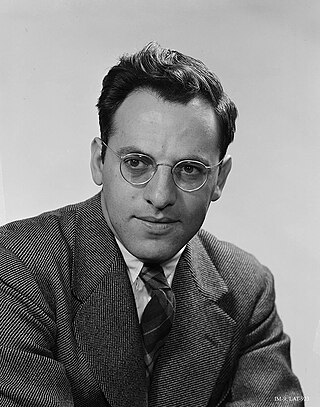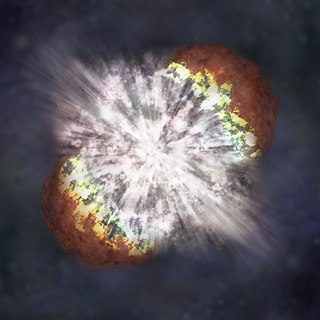Related Research Articles
The Chandrasekhar limit is the maximum mass of a stable white dwarf star. The currently accepted value of the Chandrasekhar limit is about 1.4 M☉ (2.765×1030 kg). The limit was named after Subrahmanyan Chandrasekhar.

The joule is the unit of energy in the International System of Units (SI). It is equal to the amount of work done when a force of one newton displaces a mass through a distance of one metre in the direction of that force. It is also the energy dissipated as heat when an electric current of one ampere passes through a resistance of one ohm for one second. It is named after the English physicist James Prescott Joule (1818–1889).

A supernova is a powerful and luminous explosion of a star. A supernova occurs during the last evolutionary stages of a massive star, or when a white dwarf is triggered into runaway nuclear fusion. The original object, called the progenitor, either collapses to a neutron star or black hole, or is completely destroyed to form a diffuse nebula. The peak optical luminosity of a supernova can be comparable to that of an entire galaxy before fading over several weeks or months.

Stellar evolution is the process by which a star changes over the course of its lifetime and how it can lead to the creation of a new star. Depending on the mass of the star, its lifetime can range from a few million years for the most massive to trillions of years for the least massive, which is considerably longer than the current age of the universe. The table shows the lifetimes of stars as a function of their masses. All stars are formed from collapsing clouds of gas and dust, often called nebulae or molecular clouds. Over the course of millions of years, these protostars settle down into a state of equilibrium, becoming what is known as a main-sequence star.

In cosmology, the cosmological constant, alternatively called Einstein's cosmological constant, is a coefficient that Albert Einstein initially added to his field equations of general relativity. He later removed it; however, much later it was revived to express the energy density of space, or vacuum energy, that arises in quantum mechanics. It is closely associated with the concept of dark energy.

Frederick Reines was an American physicist. He was awarded the 1995 Nobel Prize in Physics for his co-detection of the neutrino with Clyde Cowan in the neutrino experiment. He may be the only scientist in history "so intimately associated with the discovery of an elementary particle and the subsequent thorough investigation of its fundamental properties."

Hans Albrecht Bethe was a German-American theoretical physicist who made major contributions to nuclear physics, astrophysics, quantum electrodynamics, and solid-state physics, and who won the 1967 Nobel Prize in Physics for his work on the theory of stellar nucleosynthesis. For most of his career, Bethe was a professor at Cornell University.

A super-luminous supernova is a type of stellar explosion with a luminosity 10 or more times higher than that of standard supernovae. Like supernovae, SLSNe seem to be produced by several mechanisms, which is readily revealed by their light-curves and spectra. There are multiple models for what conditions may produce an SLSN, including core collapse in particularly massive stars, millisecond magnetars, interaction with circumstellar material, or pair-instability supernovae.

The cosmic distance ladder is the succession of methods by which astronomers determine the distances to celestial objects. A direct distance measurement of an astronomical object is possible only for those objects that are "close enough" to Earth. The techniques for determining distances to more distant objects are all based on various measured correlations between methods that work at close distances and methods that work at larger distances. Several methods rely on a standard candle, which is an astronomical object that has a known luminosity.
The convective overturn model of supernovae was proposed by Bethe and Wilson in 1985, and received a dramatic test with SN 1987A, and the detection of neutrinos from the explosion. The model is for type II supernovae, which take place in stars more massive than 8 solar masses.

Saul Perlmutter is a U.S. astrophysicist, a professor of physics at the University of California, Berkeley, where he holds the Franklin W. and Karen Weber Dabby Chair, and head of the International Supernova Cosmology Project at the Lawrence Berkeley National Laboratory. He is a member of both the American Academy of Arts & Sciences and the American Philosophical Society, and was elected a Fellow of the American Association for the Advancement of Science in 2003. He is also a member of the National Academy of Sciences. Perlmutter shared the 2006 Shaw Prize in Astronomy, the 2011 Nobel Prize in Physics, and the 2015 Breakthrough Prize in Fundamental Physics with Brian P. Schmidt and Adam Riess for providing evidence that the expansion of the universe is accelerating. Since 2021, he has been a member of the President’s Council of Advisors on Science and Technology (PCAST).

A Type Ia supernova is a type of supernova that occurs in binary systems in which one of the stars is a white dwarf. The other star can be anything from a giant star to an even smaller white dwarf.

The known history of supernova observation goes back to 1006 AD. All earlier proposals for supernova observations are speculations with many alternatives.

A Type II supernova or SNII results from the rapid collapse and violent explosion of a massive star. A star must have at least eight times, but no more than 40 to 50 times, the mass of the Sun (M☉) to undergo this type of explosion. Type II supernovae are distinguished from other types of supernovae by the presence of hydrogen in their spectra. They are usually observed in the spiral arms of galaxies and in H II regions, but not in elliptical galaxies; those are generally composed of older, low-mass stars, with few of the young, very massive stars necessary to cause a supernova.

SN 2006gy was an extremely energetic supernova, also referred to as a hypernova, that was discovered on September 18, 2006. It was first observed by Robert Quimby and P. Mondol, and then studied by several teams of astronomers using facilities that included the Chandra, Lick, and Keck Observatories. In May 2007, NASA and several of the astronomers announced the first detailed analyses of the supernova, describing it as the "brightest stellar explosion ever recorded". In October 2007, Quimby announced that SN 2005ap had broken SN 2006gy's record as the brightest-ever recorded supernova, and several subsequent discoveries are brighter still. Time magazine listed the discovery of SN 2006gy as third in its Top 10 Scientific Discoveries for 2007.
The Hans A. Bethe Prize, is presented annually by the American Physical Society. The prize honors outstanding work in theory, experiment or observation in the areas of astrophysics, nuclear physics, nuclear astrophysics, or closely related fields. The prize consists of $10,000 and a certificate citing the contributions made by the recipient.

Gerald Edward Brown was an American theoretical physicist who worked on nuclear physics and astrophysics. Since 1968 he had been a professor at the Stony Brook University. He was a distinguished professor emeritus of the C. N. Yang Institute for Theoretical Physics at Stony Brook University.

A hypernova is a very energetic supernova which is believed to result from an extreme core collapse scenario. In this case, a massive star collapses to form a rotating black hole emitting twin astrophysical jets and surrounded by an accretion disk. It is a type of stellar explosion that ejects material with an unusually high kinetic energy, an order of magnitude higher than most supernovae, with a luminosity at least 10 times greater. Hypernovae release such intense gamma rays that they often appear similar to a type Ic supernova, but with unusually broad spectral lines indicating an extremely high expansion velocity. Hypernovae are one of the mechanisms for producing long gamma ray bursts (GRBs), which range from 2 seconds to over a minute in duration. They have also been referred to as superluminous supernovae, though that classification also includes other types of extremely luminous stellar explosions that have different origins.
Supernova neutrinos are weakly interactive elementary particles produced during a core-collapse supernova explosion. A massive star collapses at the end of its life, emitting on the order of 1058 neutrinos and antineutrinos in all lepton flavors. The luminosity of different neutrino and antineutrino species are roughly the same. They carry away about 99% of the gravitational energy of the dying star as a burst lasting tens of seconds. The typical supernova neutrino energies are 10 to 20 MeV. Supernovae are considered the strongest and most frequent source of cosmic neutrinos in the MeV energy range.
James Wellington Truran Jr. was an American physicist, known for his research in nuclear astrophysics.
References
- ↑ Hartmann DH (April 1999). "Afterglows from the largest explosions in the universe". Proc. Natl. Acad. Sci. U.S.A. 96 (9): 4752–5. Bibcode:1999PNAS...96.4752H. doi: 10.1073/pnas.96.9.4752 . PMC 33568 . PMID 10220364.
- ↑ Marc Herant; Stirling A. Colgate; Willy Benz; Chris Fryer (October 25, 1997). "Neutrinos and Supernovae" (PDF). Los Alamos Sciences. Los Alamos National Laboratory. Archived from the original (PDF) on 2009-01-14. Retrieved 2008-04-23.
- ↑ Gerald Brown (2006). Hans Bethe and His Physics. World Scientific. ISBN 981-256-609-0.
- ↑ "Following the death of Hans Bethe last year, I have proposed a new unit called the bethe, where 1 B is 1051 ergs or 1044 J. This would replace the unit of 1051 ergs, which is commonly used by those studying supernovae – a field in which Bethe worked. Ian Mills, president of the consultative committee on units of the International Committee for Weights and Measures, has concurred and agreed that the bethe can be used." Stephen Weinberg (2006). "A Bethe unit". Physics World. 19 (2): 17. doi:10.1088/2058-7058/19/2/31.
